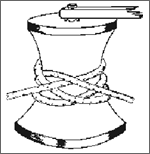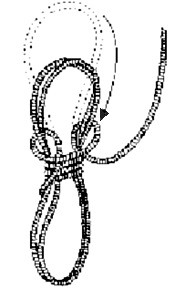 If possible, always avoid heavy shock loads. For example, when passing a towline between a stationary vessel and a moving one, never make both ends fast at once. The resulting jerk imposes a tremendous strain on the line which, if it does not damage it, may rip a cleat or bollard out. When one end has been made fast, the correct procedure at the other end is to make a figure-eight turn around the cleat or bitts, and allow the line to ease out smoothly as the load comes on. Then, check steadily and make fast as the vessel gathers way.
If possible, always avoid heavy shock loads. For example, when passing a towline between a stationary vessel and a moving one, never make both ends fast at once. The resulting jerk imposes a tremendous strain on the line which, if it does not damage it, may rip a cleat or bollard out. When one end has been made fast, the correct procedure at the other end is to make a figure-eight turn around the cleat or bitts, and allow the line to ease out smoothly as the load comes on. Then, check steadily and make fast as the vessel gathers way.
Riding turns on a winch, must be avoided. They are caused by a line wrongly lead or tailed. Often they can only be undone by using another winch and a rolling hitch to take the strain off the line.
Securing a Coil
 When coiling a line, always begin at the end that is made fast so that and twists or kinks can be chased along and run out at the far end. It is particularly important to ensure that load is never applied to a line when there is a kink in it; doing so will almost inevitably damage and weaken it. Rope that has been badly overloaded in any way may be identified by being usually hard in parts. The hardness is caused by the heat that is produced by the overload friction that fuses some of the filaments together.
When coiling a line, always begin at the end that is made fast so that and twists or kinks can be chased along and run out at the far end. It is particularly important to ensure that load is never applied to a line when there is a kink in it; doing so will almost inevitably damage and weaken it. Rope that has been badly overloaded in any way may be identified by being usually hard in parts. The hardness is caused by the heat that is produced by the overload friction that fuses some of the filaments together.
Unless lines are properly coiled, kinks will occur - with subsequent snags - when the line is run out. Nearly all laid ropes are right-handed and should be coiled clockwise to ensure smooth running out.
To make sure that your ropes wear evenly, it's a good idea to change them end for end occasionally.
The life of a rope can be extended considerably by washing it in fresh water to get rid of salt crystal, grit, and dirt. Use only soap powder - not detergent - to wash rope.
Handling and Care of Rope Fibers
Many products are designed for a specific purpose. When a use is specified on the product, use the rope for its intended application. This will add life to the product and reduce the possibility of a product failure.
When rope is repeatedly turned or twisted in one direction, it is certain that kinks will develop, unless twists are repeatedly thrown in, or out of rope. Pulling a kink through a restricted space such as a tackle block will seriously damage the rope fibers.
Outer and inner rope fibers contribute equally to the strength of your rope. When worn, your rope is naturally weakened. Where it is necessary for a rope to rub over and object, protect it with chafing gear, such as canvas wrapped and tied around the rope.
Safe working strength for rope varies from 5:1 to 12:1 or higher. For example, a rope rated at 10,000 pounds minimum breaking strength may be loaded to 2,000 pounds at a 5:1 safe working load and at 833 pounds at a 12:1 safe working load. Ignoring safe working loads can cause personal injury, damage to property or even death. If your rope is old or worn, make allowances for safety. Downgrade rope to a less critical application or discard and replace
Rope that is strong enough under a steady strain can be broken with a sudde3n jerk. Avoid shock loads whenever possible.
Sharp bends greatly affect the strength of a rope. Any sharp angle is a weak spot. Pad it for safety, and even then, be careful!
Always use the right size rope for the sheaves in block or pulleys. Too small a sheaves diameter can cause added friction and rope wear.
Prolonged use, or wear, on one part of a rope will naturally decrease its effectiveness at that point. Occasionally reverse your rope, end-for-end, to distribute the wear more evenly. A good example is an anchor line aboard a boat.
Virtually all synthetic fiber ropes are immune to damage from oil, gasoline, paint and most chemicals. To be on the safe side, however, keep your rope free of any type chemical. Natural fiber ropes are, of course, severely damaged by exposure to chemicals.
Dirt on the surface and embedded in rope acts as an abrasive on fibers. When rope becomes dirty, wash it thoroughly with clean water. Be sure to air-dry natural fiber ropes before storing.
Synthetic fiber ropes require no special storing conditions other than keeping them out of sunlight and out of extremely hot rooms. The ultra-violet rays of sunlight have a weakening effect on rope that is exposed for prolonged periods of time. Natural fiber ropes must be kept dry or they will rot in a very short time.
 If possible, always avoid heavy shock loads. For example, when passing a towline between a stationary vessel and a moving one, never make both ends fast at once. The resulting jerk imposes a tremendous strain on the line which, if it does not damage it, may rip a cleat or bollard out. When one end has been made fast, the correct procedure at the other end is to make a figure-eight turn around the cleat or bitts, and allow the line to ease out smoothly as the load comes on. Then, check steadily and make fast as the vessel gathers way.
If possible, always avoid heavy shock loads. For example, when passing a towline between a stationary vessel and a moving one, never make both ends fast at once. The resulting jerk imposes a tremendous strain on the line which, if it does not damage it, may rip a cleat or bollard out. When one end has been made fast, the correct procedure at the other end is to make a figure-eight turn around the cleat or bitts, and allow the line to ease out smoothly as the load comes on. Then, check steadily and make fast as the vessel gathers way. When coiling a line, always begin at the end that is made fast so that and twists or kinks can be chased along and run out at the far end. It is particularly important to ensure that load is never applied to a line when there is a kink in it; doing so will almost inevitably damage and weaken it. Rope that has been badly overloaded in any way may be identified by being usually hard in parts. The hardness is caused by the heat that is produced by the overload friction that fuses some of the filaments together.
When coiling a line, always begin at the end that is made fast so that and twists or kinks can be chased along and run out at the far end. It is particularly important to ensure that load is never applied to a line when there is a kink in it; doing so will almost inevitably damage and weaken it. Rope that has been badly overloaded in any way may be identified by being usually hard in parts. The hardness is caused by the heat that is produced by the overload friction that fuses some of the filaments together.